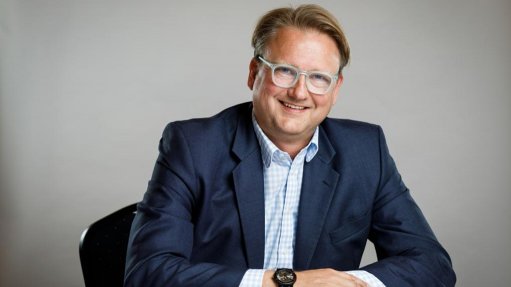
Pallinghurst Co-Chief Executive and Co-Founder Arne Frandsen.
Amongst all our investors, there’s very broad support for South Africa’s government of national unity initiative, says Pallinghurst co-chief executive and co-founder Arne Frandsen.
“I think it’s absolutely the right thing that the politicians are doing and I really hope that it’ll see the rand getting some muscles back,” an upbeat Frandsen told Engineering News & Mining Weekly in a Zoom interview.
Pallinghurst’s Sedibelo, which began operating the Pilanesberg platinum mine (PPM) on the western limb of South Africa’s platinum group metals- (PGMs-) rich Bushveld Complex in 2008, has been marking time on the wholly owned brownfield expansion of PPM into the contiguous deposits of Sedibelo Central, Magazynskraal and Kruidfontein – known as the Triple Crown properties, which have an estimated resource base of more than 60-million platinum, palladium, rhodium and gold, or four element PGM ounces.
The predominantly shallow deposits will allow for safe and sustainable mining activities for potentially more than 60 years.
The plan is for the expansion to be mined simultaneously, with ore from the existing opencast upper group two (UG2) and Merensky operation, using two decline shaft systems.
The existing PPM concentrator plant has the capacity to process the Triple Crown ore and ore from the openpits. With minimal reconfiguration, the Triple Crown UG2 and Merensky ore will be blended and processed through the existing Merensky plant, thereby significantly reducing capital expenditure and lowering operating costs.
Sedibelo also plans to commission a 110 000 t beneficiation plant at PPM using cost- and energy-efficient Kell Technology. Kell reduces energy consumption by an estimated 82%, with the associated significant reduction in carbon emissions also improving recoveries and lowering operating costs. Kell, unconstrained by concentrate grade, resistant to other impurities and not sensitive to chrome levels, is a ‘green’ hydrometallurgical alternative to traditional electricity-intensive smelting, the most environmentally harmful phase of metal production.
Sedibelo shares an interest in Kell with the South Africa’s State-owned Industrial Development Corporation and founder Keith Liddell, who conceived the smelterless concept in the late 1990s while working at South Africa’s State-owned mineral research organisation, Mintek, in Johannesburg.
Engineering News & Mining Weekly: In your view, are PGM prices coming off the bottom ?
Frandsen: If I had a dollar for each time I predicted the bottom of the PGM cycle, I would be a rich man today. It has defied gravity so many times. But it doesn’t change the fundamentals that the world as we know it will need platinum, and that platinum will predominantly come from the Bushveld Igneous Complex, so I remain positive. I guess the old saying that you either pick your timing or you pick your price is right. I believe that PGMs have a very bright future, especially if we go into the hydrogen economy and South Africa will play a very important role in that respect.
Engineering News & Mining Weekly: What level of PGM price will be required to make it economically feasible to press ahead with the Triple Crown, Kell, renewable energy and other project developments?
Frandsen: I don’t think that there’s a specific number. The thing that we are doing right now, and that our management teams are diligently working on, is really to try and optimise our mine, especially the lead time to get underground, where we have some of the most attractive grades that are still available on the western limb [of the Bushveld Complex]. I would say that it’s maybe not as much price, but consistency. We don’t like the kind of fluctuation in prices that we have seen. It’s volatility, but unfortunately only in one direction, and what we really need to see is some stability and some positive views on the hydrogen economy. When that’s there, we will start up as soon as we can.
How will Kell technology be implemented under these circumstances?
These circumstances make Kell even more relevant. I think that what we’re seeing here now is that we need to build an underground mine for the twenty-first century and that includes Kell.
What is the latest situation with Sedibelo’s Mphalele project on the eastern limb of the Bushveld Complex?
Again, we have used this downtime to focus on Mphalele and it remains a very attractive project and an integrated part of Sedibelo’s future. We will, for sure, mine that asset. The question is just when. Battery Supply Chain Investments Pallinghurst’s North American interests in the battery supply chain include investments in Nouveau Monde Graphite, which develops graphite-based materials to propel the energy revolution, Talon Metals, which has a nickel, copper and cobalt asset, and Nemaska Lithium, a lithium hydroxide asset. Engineering News & Mining Weekly: To what extent, in your view, are battery materials succeeding in helping to bring about the clean energy transition? Frandsen: I will say that there is no doubt that electrification is a fact of life. And I think there is no doubt at all that we will all be driving battery-powered cars in the future. The question is, just how near is that future? But I don’t think that anyone believes that we can return to the other side of the Rubicon. We have crossed that. It is clear that in most countries, China especially, that battery-driven vehicles have cemented their position in the future. I don’t say there will not be any internal combustion engines, but I have no doubt that the future will be green and the future will be EV.